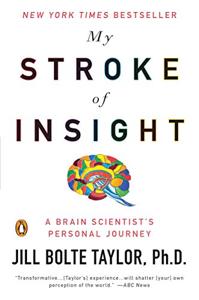
Want to learn the ideas in My Stroke Of Insight better than ever? Read the world’s #1 book summary of My Stroke Of Insight by Jill Bolte Taylor here.
Read a brief 1-Page Summary or watch video summaries curated by our expert team. Note: this book guide is not affiliated with or endorsed by the publisher or author, and we always encourage you to purchase and read the full book.
Video Summaries of My Stroke Of Insight
We’ve scoured the Internet for the very best videos on My Stroke Of Insight, from high-quality videos summaries to interviews or commentary by Jill Bolte Taylor.
1-Page Summary of My Stroke Of Insight
Overview
In My Stroke of Insight, neuroanatomist Jill Bolte Taylor describes the stroke she had in 1996 when she was 37. She combines her perspectives as a scientist and patient to describe the symptoms of her stroke and how they affected her life.
Taylor had a full and active life as a Harvard Medical School researcher. But she suffered from a stroke that left her with severe brain damage, which disrupted many of her memories and other important capacities. However, Taylor was able to overcome all the deficits by working hard with the help of her mother over 10 years later.
Taylor woke up with a migraine one morning. She lost her cognitive abilities and was fascinated by the process. It wasn’t upsetting to her personally, as she felt at peace with herself. As she lost some of her sense of self, she grieved for what she had once been in life but then moved on and felt at ease with the world around her. In that moment, Taylor’s consciousness separated itself from negative aspects of living and was filled with tranquility.
Taylor believes that her spiritual experience was biologically determined. She likens it to the Buddhist concept of nirvana, which means a state free from suffering. Her left brain was damaged and quieted her inner voice, which is a stream of constant commentary. This freed up her right brain to experience bliss.
Even when she was still recovering from her stroke, Taylor felt a strong desire to share her experience. Anyone can achieve the right-brain tranquility that she experienced after her recovery. Her recovery wasn’t easy, but it was worth it in the end. She’s eager to tell others how they can recover as well.
Key Takeaways
Health care providers should be more patient-centered in their care. In convalescing, as in everyday life, it’s important to cultivate an attitude of gratitude. Negative self-talk can be damaging for everyone, especially people recovering from a brain injury. Sleep is crucial to recovery from a stroke because it has incredible healing properties.
Taylor’s brain injury caused her to have a spiritual experience in which she felt connected to everything around her. The right and the left sides of the brain help people perceive and interact with their environment.
When recovering from a stroke, it can be useful to break down large tasks into smaller ones.
Key Takeaway 1: Health care providers should be more patient-centered in their care.
Taylor writes about how she felt uncomfortable during her first hospital stay. She had to deal with policies and practices that were not conducive to healing, which made the experience unpleasant for her. Taylor argues that there should be a more patient-centered approach in hospitals.
Health care settings in the United States are typically designed with doctors and nurses in mind, not patients. However, there is a growing interest in patient-centered care. This has led to disruptions that can lead to stressors such as noise pollution, lack of privacy and consideration for incapacitated patients. These problems can sometimes lead to post-hospital syndrome which puts patients at risk for relapsing or contracting new health problems.
A study published in the Journal of the American Medical Association (JAMA) suggests that doctors should look at pediatric institutions for strategies to make patients and their families feel more comfortable. Hospitals could invest in cheerful décor, provide creature comforts like better food, and schedule things such as doctor’s appointments so they’re convenient for patients. They also suggest making sure there are opportunities for restful sleep, serving appetizing foods, and encouraging patients to move around when possible. Doctors can help by wearing name tags and providing important information on paper instead of just speaking it aloud if a patient has trouble understanding or following verbal instructions.





